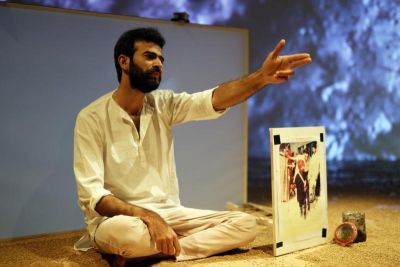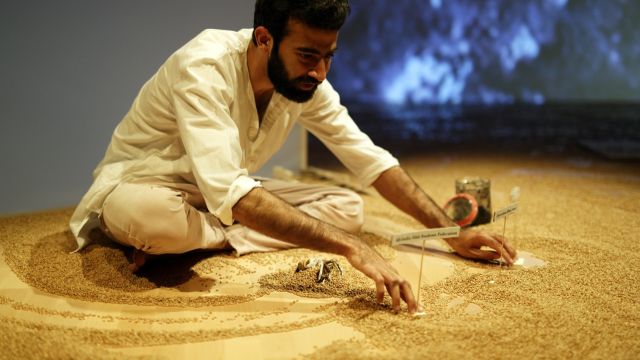My Home At The Intersection
Director, writer and performer Abishek Thapar has a tale to tell, and it spans back over 30 years. It is a tale of personal reflection, redemption and self-healing that is told using photographs, video film, slides and deeply personal, carefully paced story telling. This Australian premiere is a unique piece of performance that can only be told by Thapar, for it is his story.
Born in the Indian province of Punjab, Thapar’s story details family history, heritage and loss, starkly framed in times of war and political and religious unrest.
The choice of the venue seemed unusual, but it quickly became apparent that the venue was perfect, and cleverly set up for this intimate performance. We were met in the foyer by Thapar, a gentle, softly spoken man, who invited all of the audience to taste from his grandfather’s 1992 jar of lemon pickle. It is the last jar in existence, and from that moment, Thapar’s tale began. We descended the steps into the bowels of the Festival Theatre, were asked to remove our shoes, and invited into a room scattered with a carpet of grains of wheat. A few chairs were provided and the floor also had chair pads, enabling the fit and flexible to be up close and strongly physically connected to this story.
Thapar and his family fled their much loved home during a period where over 5000 Sikh militants, in their fight for their own homeland, sacked the Punjab’s Golden Temple, built in 1604, beginning a period of terror, murder, kidnappings and political struggle. Using the wheat and small paper models as his canvas, he created landmarks, roads and rivers, weaving the stories of his growing up in a close, strongly united family beset by terror and danger.
 Strangely jarring, but startlingly clear at the end, he told the story of impressing students and staff at his new school by dressing up, complete with his father’s revolver, as a terrorist. The family all helped, collaborated on the script and costumed him with great care. The seeds for the rest of his story were sown. It would be a spoiler to reveal more, but the family struggle with Sikhism (and the tradition of one boy commonly being raised as a Sikh), was explored, making logical that which could have been bizarre.
Strangely jarring, but startlingly clear at the end, he told the story of impressing students and staff at his new school by dressing up, complete with his father’s revolver, as a terrorist. The family all helped, collaborated on the script and costumed him with great care. The seeds for the rest of his story were sown. It would be a spoiler to reveal more, but the family struggle with Sikhism (and the tradition of one boy commonly being raised as a Sikh), was explored, making logical that which could have been bizarre.
The family regrouped many years after escaping their Punjab home, recreating their first, much loved home. Over the ensuing 27 years, over 27,000 homes were abandoned and deserted as people fled the uprising and violence. Tragically, peace has not salved the wounds or created a happy and secure community for those who fled, stayed or came later. History books have been rewritten to sugar coat the brutality, but Thapar courageously points out that whilst he vacillates between remembering and forgetting, the truth cannot be rewritten.
Thapar is gently insistent when telling his tale. Sitting cross-legged, fluidly introducing film, family photos and confronting images that take up a whole wall, he uses silence, pauses and unwavering audience eye contact to hold the audience for what could seem an ordinary family story, but of course, is anything but.
Once again, the OzAsia Festival gave us a lens to understand culture and life experiences that are so different from that of most locals.
This was a passionate and creative narrative with a universal message that should not be ignored.
Jude Hines
Photographer: Thomas Lenden
Subscribe to our E-Newsletter, buy our latest print edition or find a Performing Arts book at Book Nook.

